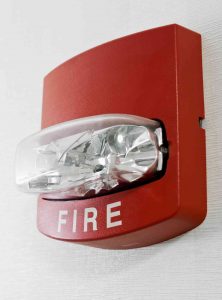
If you’re a property owner with a fire alarm system in your building, you know how important it is. Timely detection and reporting of fires are essential to limiting the damage it can cause.
If you’re a property owner with a fire alarm system in your building, you know how important it is. Timely detection and reporting of fires are essential to limiting the damage it can cause. And even more important, a fire alarm system keeps the people in your building safe if a fire breaks out. There are five major parts to a fire alarm system.
The Control Panel
This component is the control center for your fire alarm system. Is it the center of operations, monitoring all of the other components and protecting your building.
The Power Supplies
Your fire alarm system should have access to two power supplies, a primary one that it uses constantly and the second one as a backup in case of a power failure. The most common primary power source is the current that powers your building, while the most common secondary source is a battery.
The Initiating Device
The initiating device is the input that triggers the system to know there is a fire. These can be manual, meaning someone has to do something to notify the system, such as pull a pull station or break the glass on a glass station. They can also be automatic, such as heat detectors, smoke detectors, or flame detectors. Depending on the use of your building, you should consider investing in a commercial fire alarm system that has both.
The Notification Appliance
The notification appliance is how the system alerts the building’s inhabitants that there is a fire so they can safely exit. This is the audio and visual alarm that you normally think of with a fire alarm: strobe or flashing lights, and horns, bells, chimes, or siren sounds. Occasionally this may also include EVACS, or Emergency Voice Alarm Communication System, which is a prerecorded message directing people where to go and how to exit the building. This is especially useful in a commercial building where people may not have participated in drills and training.
The Building Safety Interface
The building safety interface allows the fire alarm system to control other elements of the building when needed. For instance, if a fire was in one area, it could adjust the air movement so that toxic smoke doesn’t flow into other areas and harm people. Other systems that could be included in this interface are lighting, process control, human transport, and more, depending on your industry.
Commercial and Residential Fire Prevention from Judd Fire Protection
If you want to ensure your home and business are safe throughout the year, trust Judd Fire Protection, LLC. We have over two decades of experience in designing, installing, inspecting, and repairing residential and commercial fire protection systems. We serve clients throughout Maryland, Pennsylvania, Washington, D.C., Virginia, and West Virginia. If you are interested in finding out more about our services and protecting your home and business, give us a call at 410-871-3480 or contact us online. For more fire safety tips, follow us on Facebook, Twitter, and Pinterest.
